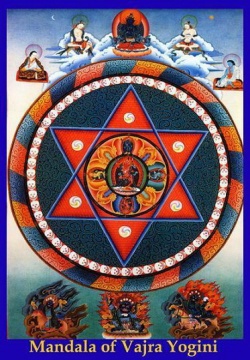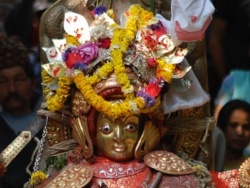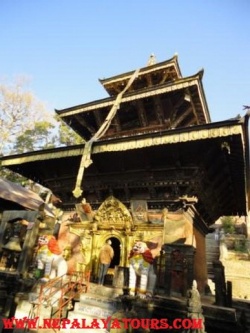Vajrayogini Temple of Samkhu
by -Dr. John K. Locke S. J.
One of the most ancient Buddhist sites of Nepal is tucked away among the pines on top of a knoll above the village of Samkhu, north and a bit east of the city of Bhaktapur. Most Nepalis today know the site as the shrine of Vajrayogini, but Newars still call it by its more ancient Name: Gum Baha. A motorable road out of the village leads one to the foot to the hill. From here the pilgrim climbs up the flagstone steps towards the dark pines above. Partway up the steps is a large triangular stone worshipped as Bhairav and opposite this a large, pot-bellied image of Ganesh. To the side of Ganesh is a rest house. Where in earlier Times the pilgrim would leave his shoes before proceeding to the scared area of the shrine above. About half Way between this Bhairavthan and the top is a large Stupa. As the pilgrim emerges from the stairway his Eyes turn to the left where in an cramped, open area rise two Gems of Nepalese architecture, a larger temple whose three gilt roofs sparkle in the sunlight coming through the Trees and a smaller two-roofed temple to the Right. The larger temple is the shrine of the powerful Buddhist tantric Vajrayogini. Approaching the temple the pilgrim’s gaze falls upon the central figure in the intricate gilt Torana over the main doorway. Glimmering in the shadowy Light of the temple varanda. Her eight hands hold a variety of tantric Symbols. She is an enigma: her face speaks of Peace and serenity, or perhaps abstraction, yet her topmost Right hand brandishes a gilt sword, and stands in a Dancing Posture treading underfoot two prostrate figures. She wears a graceful, flowing skirt, but over is a garland of human skulls. Her two main hands hold violent Symbols: the chopper and the skullbowl. Yet she is surrounded by seven peaceful and serene figures: Vajrasattva, Vajradhara and the five Transcendent Buddhas (Vairocana, Amitabha, Amoghasiddhi, Aksobhya and Ratnasambhava).
If the pilgrim ventures into the shrine itself he will see a much larger yet different image of Vajrayogini. Though the figure is almost completely covered with a variety of garments and ornaments, enough is clear to see her red complexion and her two hands, one brandishing a sword and the other holding a blue Lotus. In her presence the pilgrim experiences a Feeling Peace and satisfaction for her Mantra is powerful enough to destroy all obstacles, avert all calamities, and protect her devotee photography is never permitted, for the photo would draw away some of her Power. Who is this Vajrayogini, who resides not only here in Sankhu but also in Pharphing and other places in the Valley? The priest on duty might tell the pilgrim that she is Khadgayogini for she holds the sword (khadga). Yet she is not really a yogini at all, for yoginis are always portrayed naked, with one foot flying in the air and usually with a terrifying mien. If the pilgrim chances to glance at the inscription in the courtyard he will see that she is called Ugratara-Vajrayogini. Ugratara (the terrifying Tara) is a tantric Form f Tara, the consort of the Bodhisattva Avalokiteshvara. She is also known as the Blue Tara or Ekajata Tara. As described in the tantric texts she is indeed terrifying: blue of color, dwarfed and obese she treads upon corpses, laughing with red and rounded Eyes, grotesque buck teeth and a protruding tongue. She wears a tiger skin and her ornaments are snakes and a garland of human skulls. She has between two and twenty-four hands which hold a variety of tantric Symbols and Weapons.
Vajrayogini is not so terrifying and she is not blue but red, which is the proper color of Vajrayogini. Yet she has been called Ugratara-Vajrayoginiat least since 1775 when King Pratap Malla of Kathmandu put up that inscription after he built the present temple. Perhaps the most that can be said is the she is a peculiarly Nepalese Form of the terrifying Blue Tara, possibly based on an iconographic source that has been lost. There is a story that this Ugratara was brought to Nepal by Bengali priests about A. D. 1350. Whatever the Truth of this story, the site is far more ancient. If the pilgrims turns from the main shrine to the smaller two-roofed temple to the Right he begins a journey into the past and a much earlier tradition of Buddhism. The gilt Torana over the main doorway depicts a late figure: the tantric Form of Amitabha with three faces and twelve arms sitting in vajrasana on the Peacock throne. He is flanked on his Right by a four-armed female figure, Prajnaparamita and on his left by the Bodhisattva Avalokiteshvara. Together they symbolize the Three Jewels: The Buddha, The Dharma and The Sangha. Inside the temple, instead of an image, is a caitya over a thousand years old. This caitya points to the long history of this site and its other Name: Gum Baha or Gum Vihara, “The Forest Monastery. An inscription of A. D. 608 put up by King Amsuvarma mentions a grant for Gum Vihara, one among many such institutions so favored by the king. The oldest and most reliable of the Nepalese chronicles, tells us that King Manadeva (A. D. 464-505) retired to Gum Vihara at one Time to do penance. Later chronicles add that because of his penance a caitya arose there spontaneously, clearly a reference to this caitya which the people still call “a swayambhu catya” a Self-existent caitya. A fragment of an inscription found at Sankhu. And from this same early period, refers to the “mahasanghika Bhiksu Sangha”, the community of Buddhist Monks who follow the Mahasanghika tradition, the only reference from this period to a specific Buddhist school or sect.
Scholars speculate that the Monastery is probably even older than this period. Many Buddhist Monasteries were founded in this early period when kings calling themselves “Licchavi” ruled Nepal. But the culture of the Licchavis was highly Sanskritised, and the Monasteries founded in their day bear Sanskrit names. “Gum” is not a Sanskrit word, but a Tibeto-Burman would word meaning a “forest”. Chronicles tell us that the Valley was ruled earlier by Kirata kings. Perhaps it was in their Time that this “Forest Monastery” was founded. If the pilgrim moves round the rest of the complex he will see tantalizing bit and pieces of the intervening history. North of the enshrined caitya are four small caityas datedfrom the fifth to the eight centuries. A short stairway leads up to another level and an enclosed, paved courtyard with a sunken fountain in the center and surrounded by rest houses and residential quarters. Here the current custodian of the shrine stays when he tends the shrine. He belongs to a still extant Sangha of four lineages of Vajracaryas and Sakyas who since medieval Times have lived here. They Form The Sangha of this Monastery and still tend its shrines by turn. Today they live in the village below but must stay here in the traditional Monastery during their period of service. On the ground floor of the building where this priest stays is a small room. To the left as one enters is a large gilt copper caitya about five feet tall. To the left of this is a colossal cast copper or bronze head of The Buddha. The image is partially buried and it is impossible to see how much more than the head there is. This has been dated to the fifth century A. D. On the floor above this is another shrine which contains a duplicate image of Vajrayogini and two other astonishing piece. The first is a solid cast bronze image of The Buddha standing with his Right hand showing the gesture of granting a boon and his left hand clasping his Robes at the shoulder. The image stands about 52 inches tall and has been dated to the eleventh century. Local people have forgotten who this image is and, fopr some long-forgotten reason, refer to is as “The Blacksmith’s Queen”. Near The Buddha stands an image of Padmapani Lokesvara, again of solid bronze and standing about three feet high. Also an exquisite piece, this has been dated to the thirteen of fourteen century.
If the pilgrim should come to this shrine on the full-moon day of the month of Caitra (March-April), he could join the procession which takes the duplicate image of Vajrayogini down to the village below on her feast day, a celebration which links this shrine and its long history with the daily Life on the Buddhists of Sankhu village. Should he comes at the Time of the annual worship of lineage Deities, he would find Sakyas and Vajracaryas from Patan, Kathmandu, Banepa and Panauti gathered here to worship the enshrined caitya as their lineage Deity. This caitya (or the one along the stairway below) is worshipped by people from Wam Baha in Patan, by people from Jhwa Baha, Dhwaka Baha, Gam Baha, Makhan Baha, Itum Baha, So Baha, Ko Hiti Baha, Syangu Bahi, Na Bahi, Nhaykan Bahi, Cwakan Bahi, Arakhu Bahi in Kathmandu, Nhu Baha in Banepa and Nhu Baha in Panauti as their lineage Deity. All of them have links to the ancient shrine and community of Gum Vihara, which they renew at least occasionally by returning to this the original site of their lineage Deity. To the causal visitor Sankhu may seem a confusing place, but a little study of its treasures beings to unravel for the visitor some of the historical stands that make up the rich fabric of the culture of Nepal.


